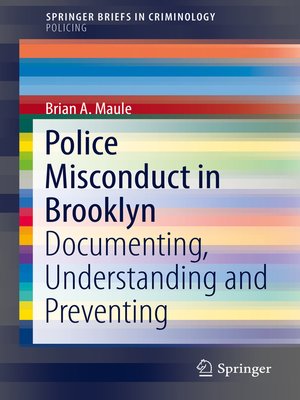Police Misconduct in Brooklyn
ebook ∣ Documenting, Understanding and Preventing · SpringerBriefs in Criminology
By Brian A. Maule

Sign up to save your library
With an OverDrive account, you can save your favorite libraries for at-a-glance information about availability. Find out more about OverDrive accounts.
Find this title in Libby, the library reading app by OverDrive.



Search for a digital library with this title
Title found at these libraries:
| Library Name | Distance |
|---|---|
| Loading... |
This Brief explores police misconduct, through the lens of a 5-year study of civil liability cases against the New York Police Department in Kings County (Brooklyn), New York. The confluence of police misconduct and civil liability is an issue of growing concern for many communities throughout the United States. One measure of the severity of these concerns is the increase in the number of lawsuits alleging police misconduct and the civil liability resulting from these lawsuits.
Using Brooklyn, New York as a case study, the author of this Brief uses lawsuits that resulted in a settlement or jury award, over a five-year period, as its measure of police misconduct. Police misconduct has many tangible and intangible consequences for a community, such as violations of the law, police brutality, social consequences, and long-term public trust of the police. On a very practical level, as the author demonstrates, the up-front financial costs of prevention, training, and support to curb police misconduct are less expensive than the costs of civil liability payments for lawsuits.
This perspective creates a strong argument for policymakers for enhancing police training and police misconduct prevention programs. This work will be of interest to researchers in police studies, as well sociology and public policy.
Using Brooklyn, New York as a case study, the author of this Brief uses lawsuits that resulted in a settlement or jury award, over a five-year period, as its measure of police misconduct. Police misconduct has many tangible and intangible consequences for a community, such as violations of the law, police brutality, social consequences, and long-term public trust of the police. On a very practical level, as the author demonstrates, the up-front financial costs of prevention, training, and support to curb police misconduct are less expensive than the costs of civil liability payments for lawsuits.
This perspective creates a strong argument for policymakers for enhancing police training and police misconduct prevention programs. This work will be of interest to researchers in police studies, as well sociology and public policy.







